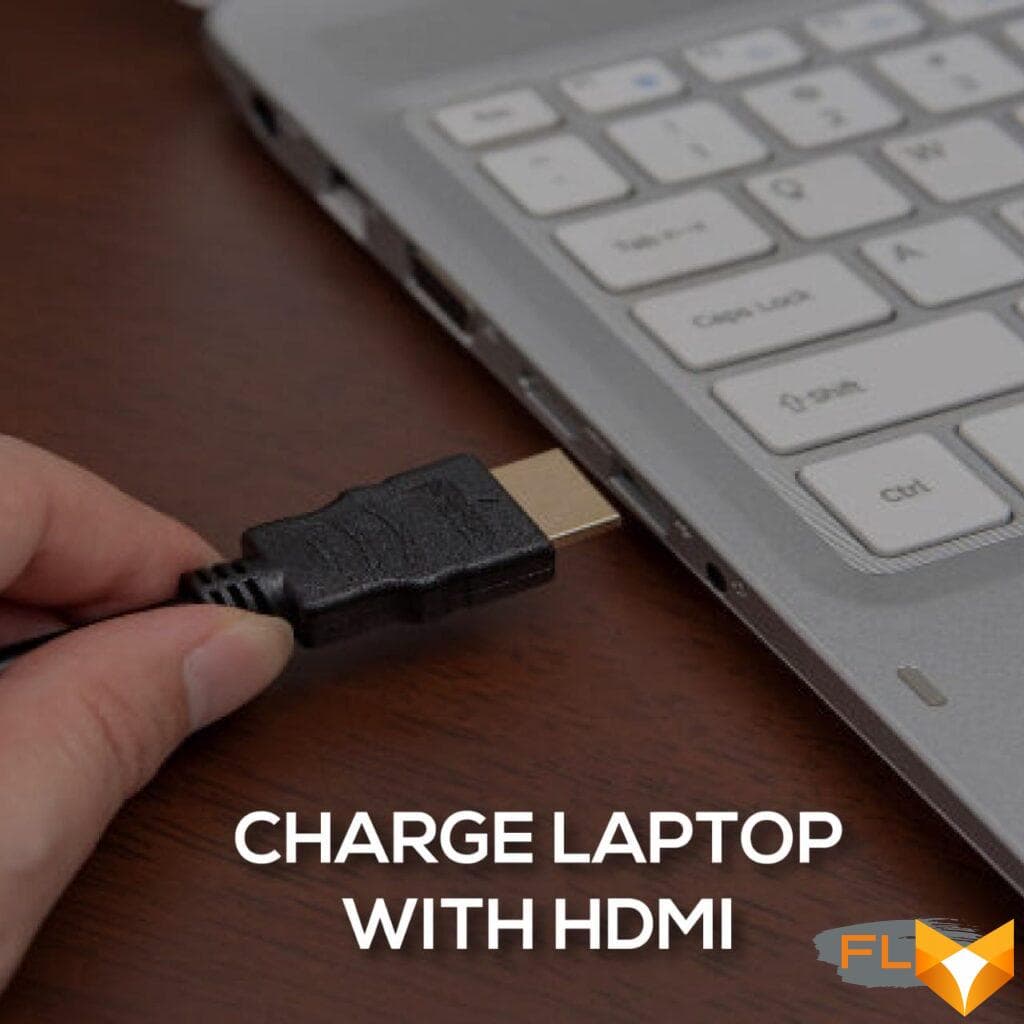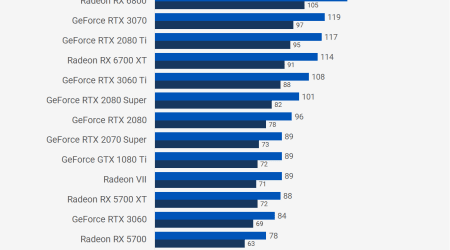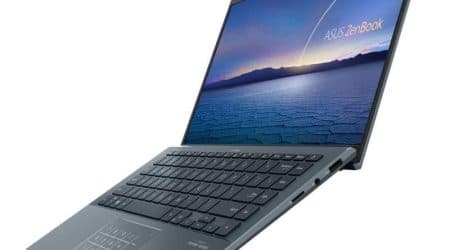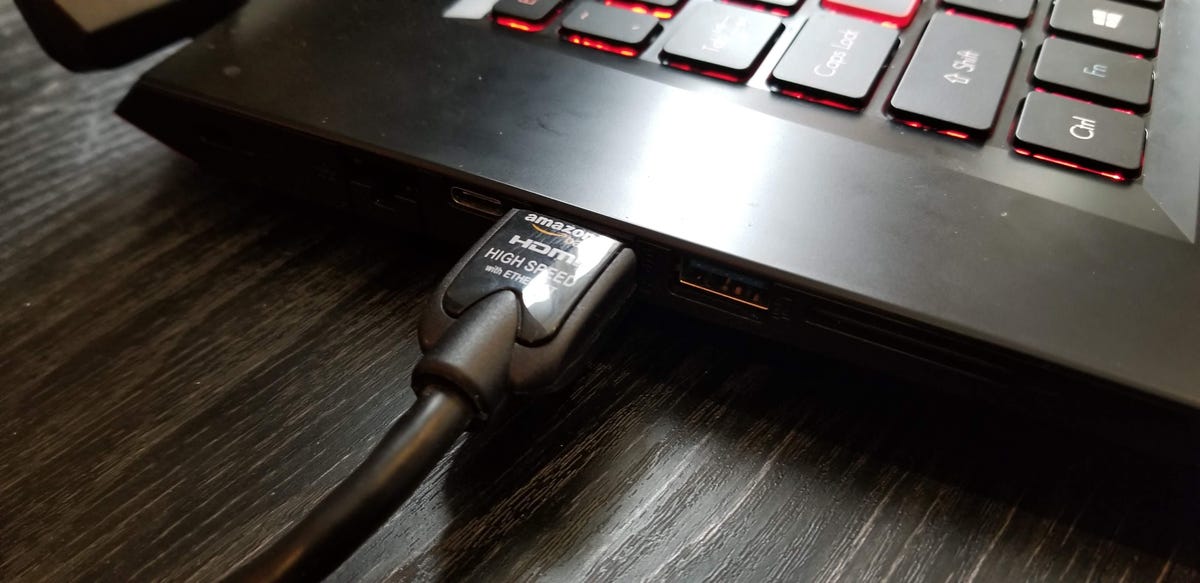


Technology is often thought of as sophisticated and highly complex, and while this is partially true, there are times when it surprises us with its simplicity and versatility. A potent example of this is the potential to power your laptop using an HDMI cable – a connection we often associate solely with audio and video transmission. This article aims to serve as a comprehensive guide on how you can harness this potential and use it as an alternative to your regular charging process.
With the increasing reliance on various gadgets, running out of battery on your laptop can be a significant inconvenience. However, few people know that the familiar HDMI port on your device can also double as a charging port in specific scenarios. While it may sound surprising or even far-fetched, driving power to your laptop through an HDMI cable is entirely possible, and this article will guide you through it.
Note: While the method described in this guide is efficient, it should not be regarded as a substitute for your laptop’s regular charger. It serves as an alternative solution when your conventional charger is not available and should be used with caution.
The function of HDMI ports has broadened over the years from merely serving as conduit for high-definition data transfer, to having the capacity to charge gadgets. This capacity is what makes charging your laptop through an HDMI port possible, thereby giving a new dimension to digital convenience.
Grasping the Concept and Uses of HDMI
HDMI or High-Definition Multimedia Interface, is an important aspect of electronic devices such as laptops, televisions, and gaming consoles. This digital interface technology, not merely connects devices, but facilitates transmission of high-quality audio and video data from one device to another without compressing the data.
The Purpose of HDMI
The primary function of HDMI is to enable communication between compatible digital audio devices, computer monitors, and digital televisions as it ensures the reception of crisp sound and clear visuals. Unlike analogue cables which can impair image and sound quality, HDMI delivers pure digital signals thus optimising your overall multimedia experience.
One significant attribute of HDMI is that it can handle multiple channels of audio and video through a single cable, alleviating the need for multiple wires. Just imagine a cleaner desk space with lesser cables!
Furthermore, HDMI technology incorporates Consumer Electronics Control (CEC) functionalities. This allows the user to control multiple devices connected by HDMI cable with only one remote, demonstrating the convenience that HDMI technology brings to the table.
Different Versions of HDMI
- HDMI 1.0: The basic version, capable of transmitting 3.96 Gbit/s of data.
- HDMI 1.2: Introduced the capability to transfer one-bit audio, used by Super Audio CDs.
- HDMI 1.4: Saw the addition of an Ethernet channel, allowing devices to share internet connections.
- HDMI 2.0: Increased the maximum data rate to 14.4 Gbit/s and introduced support for 4K video at 60Hz.
- HDMI 2.1: Provides an increased bandwidth up to 48 Gbit/s and support for 8K video at 60Hz or 4K video at 120Hz.
In conclusion, understanding HDMI and its functionality is critical in this digital age as it significantly impacts our daily multimedia experiences. It’s more than just a cable; it’s a technology that connects, communicates, and controls.
Necessary Tools for Powering Up Your Laptop through HDMI
In order to power up your laptop using an HDMI entry, specific equipment is needed. This is not a straightforward process as HDMI ports are usually used to transfer audio and video data, not power. However, by making use of certain adapters and converters, it’s possible to use them for power supply in emergency situations. Remember this process might vary depending on the brand and model of your laptop and the accessories required might differ.
Adapters & Converters
One of the most important tools needed is a HDMI to USB converter. This specialised converter allows electrical power to be drawn from the HDMI port and transferred to a USB end that can be connected to the power intake of the laptop.
In addition to the HDMI to USB converter, you may require a USB-C laptop charging cable. Many modern laptops use a USB-C port for charging, and as such, a cable that ends in a USB-C connector may be necessary. Keep in mind that the effectiveness of the power transfer can depend on the quality of the cables and converters used.
External Battery Packs
If your laptop’s battery life is generally short, an external battery pack or power bank can offer additional power. These devices often come with USB ports that can either power your laptop directly or that can be used in conjunction with a HDMI to USB adapter for charging.
Note that in some cases you might also need a special HDMI power injector. This device ‘injects’ power into the HDMI cable and may be necessary if you’re dealing with certain types of video devices that don’t supply enough power through their HDMI ports.
Prior to attempting this process, ensure your laptop’s compatibility with HDMI power input. Always follow the laptop manufacturer’s instructions and use the process with caution as any improper use may result in damage to your laptop or adapter.
Tutorial: How to Power Your Laptop via HDMI?
The task of harnessing the HDMI port to provide power to your laptop is not a straightforward one as HDMI interfaces are not designed for this purpose. Here is a procedure to follow if you intend to attempt doing so. Kindly note that this might not work with all devices, and there’s always a risk involved.
Detailed Instructions
Step 1: Verify that your laptops HDMI port supports Ethernet Channel Technology. This is because the HDMI standard incorporates a feature known as HDMI Ethernet and Audio Return Channel (HEAC) which allows devices connected via HDMI to share an internet connection. Theoretically, one can exploit this feature to provide power.
Step 2: Identify the HDMI pin that corresponds to the HDMI Ethernet and Audio Return Channel (pin 14). You will need to purchase a specific HDMI cable for which the aforementioned pin is brought out separately or has the ability to handle it.
Step 3: Connect your laptop and a compatible power source using the HDMI cable you acquired. The power source can be another laptop or desktop computer, or a wall socket if the HDMI cable can be adapted to this application. Please be very careful when working with electricity to avoid damaging your devices or causing harm to yourself.
Step 4: Test whether your laptop is receiving power. If there’s an LED indicating the charging status, it should light up.
Please note that this is currently a theoretical discussion owing to the highly specialized nature of the requirements. Proceed with caution if you wish to try out the concept on your devices.
Advantages of Powering Your Laptop via HDMI
Using an HDMI port as a power source for your laptop offers many advantages. Taking advantage of this technique not only enhances your convenience factor but also brings notable benefits related to portability, power consumption, and usability.
Enhanced Portability
One of the major benefits of using HDMI for laptop charging is the portability it offers. Modern-day users, especially those constantly on the move or those working in ever-changing environments, find it cumbersome to carry around bulky power adapters. Charging your laptop via HDMI eliminates the need for carrying extra cables or adapters, hence increasing portability.
Lower Power Consumption
Powering your laptop through an HDMI connection can also lead to electricity conservation. Compared to traditional power adapters, HDMI can control the flow of electricity more effectively, leading to lower power consumption and extending your laptop’s battery life.
Increased Usability
Another merit of utilizing HDMI as your laptop power source is the increased usability. For instance, you could be presenting at a conference or participating in a seminar where your presentation device has an HDMI port. This can work as a power source, allowing you to charge your laptop simultaneously while presenting. Noteworthy is that while HDMI ports do not traditionally offer electricity supply, equipped laptops and devices can capitalize on HDMI alternate modes to gain this functionality.
- Portability: Eradicates the necessity to carry around hefty power adapters.
- Lower Power Consumption: Effectively manages electricity flow, hence conserving energy and boosting battery life.
- Increased Usability: Wider range of application, with the ability to power up your laptop in diverse settings.
In conclusion, powering your laptop through HDMI does not only provide sheer convenience and portability but also aids in power consumption and widens its usability.
Possible Problems When Trying to Power a Laptop Via HDMI and How to Address Them
When seeking to power your laptop through HDMI, it’s possible to come across numerous hiccups. Let’s delve into some common hitches you may encounter and their corresponding solutions.
Issue: Power Transmission is Insufficient
This issue primarily crops up due to a subclass of HDMI cables that does not have the necessary capacity to transmit sufficient power to the laptop.
Solution: An easy solution is upgrading to a better version; ideally, an HDMI cable with a higher power transfer capacity. Online platforms and local shops offer a broad variety of HDMI cables suitable for diverse power needs.
Note: Ensure your HDMI cable is always in good condition to avoid any possible damage to your laptop’s circuitry.
Issue: Laptop Does Not Support HDMI Power
Some laptops may not support charging through HDMI. Before attempting to power your laptop via HDMI, ensure that it supports the feature.
Solution: Verify from your laptop’s manual or manufacturer’s website if your device supports powering via HDMI. If it does not, consider other alternative charging methods.
Issue: Configurations Not Correctly Set
In some instances, the system configurations may not be correctly set to support HDMI power transmission.
Solution: Make sure all configurations align with the specifications in your laptop’s manual. They should also meet the power needs of your laptop.
Final Word
Charging your laptop through an HDMI port can offer a convenient alternative to carrying around multiple chargers for your devices. However, you may run into challenges along the way. Understanding these issues and knowing how to solve them is vital to ensuring a smooth charging experience.
Cautions to Consider When Powering Your Laptop Via HDMI
What looks like a simple method of charging your laptop through an HDMI connection can turn into a complex process that requires meticulous attention. There are some necessary precautions to take when seeking to power up your laptop in this way.
1. Proper HDMI Adaptor or Converter
Using the right adaptor or converter is a critical precaution. A standard HDMI cable has no power capabilities. It facilitates audio and video signals, but not power. Charging requires an HDMI to USB adaptor that supports Power Delivery (PD) or an HDMI cable with built-in power capabilities. Ensure the adapter is compatible with your laptop, and buy from a reputed brand to avoid damaging your device.
2. Check the Power Output
Make sure the HDMI port and adapter combination is capable of providing enough power to charge your laptop. This can usually be checked by looking at the product specifications on the manufacturer’s website or on the packaging of the product itself. Remember to cross-check this against the power requirements for your device.
3. Avoid Overheating
Prevent overheating by avoiding charging your laptop through HDMI for extended periods, as it can overheat the laptop and adapter. This is especially true if you continue using the laptop while it charges. Allow a cooldown period for your device.
4. Keep Away from Water and Dust
It is essential to maintain your laptop and HDMI connector in a clean and dry state. Exposure to dust or water can damage your device and adapter, possibly resulting in a permanent system crash.
5. Disconnect When Not in Use
Always disconnect the HDMI-USB connector when you are not charging the laptop. This helps in avoiding unnecessary power consumption and potential overheating issues.
By following these guidelines, you can charge your laptop using the HDMI port safely while ensuring the longevity of your device.
Understanding HDMI Versions and Their Role in Powering Your Laptop
With advancements in technology, HDMI has evolved over the years, bringing forth different versions, all which have significant implications on powering your laptop. The HDMI technology does not only transmit video and audio data digitally, but it also has the potential to deliver power.
The Impact of HDMI Standards on Laptop Charging
Traditional HDMI cables were primarily designed for audio and video transmission. They could not transfer power due to the limited current capacity of the conductors. Given this, older versions of HDMI such as HDMI 1.0 to HDMI 1.4b may not facilitate laptop charging.
However, with the emergence of HDMI 2.0 and the subsequent versions, the technology presented improved capabilities. While it did not wholly revolutionize the power delivery aspect, there was a significant improvement in power handling capacity, making laptop charging more viable. Despite these advancements, it should be noted that the power delivery via HDMI is less effective when compared to traditional laptop chargers.
Another crucial enhancement introduced over the years was the HDMI Ethernet Channel (HEC) feature. This technology merges the benefits of an HDMI cable and an Ethernet cable into one, making power transfer more efficient and enabling your laptop’s charging ability.
- HDMI 1.0-1.4b: These versions focus mainly on audio-visual data transfer. They lack adequate power transfer capabilities, hence may not support laptop charging.
- HDMI 2.0 & Above: These HDMI versions offer improved power handling capacity, making it possible to charge laptops, although less efficient compared to conventional laptop chargers.
- HDMI Ethernet Channel (HEC): This technology enhances power transfer efficiency, thus promoting your laptop’s charging ability.
To sum up, while HDMI technology has significantly evolved and now offers improved power handling abilities for laptop charging, it is critical to note that it may not fully replace the traditional laptop charger’s effectiveness and efficiency. Therefore, it might be best to use it as an alternative way of charging rather than the main method.
Different Methods to Power Your Laptop Aside from Using HDMI
Although charging a laptop through an HDMI port is possible, it’s worth noting that this method is not prevalent or as straightforward as it seems. HDMI ports are designed principally to transfer audio and video signals, not for power transmission. Therefore, you may encounter apparent limitations, including reduced charging efficiency and potential device damage. So, let’s delve into other, more safe and reliable alternatives for powering your laptop.
Conventional AC Adapter
Undeniably, the most common and efficient method to charge your laptop is by using the conventional AC adapter. This method uses the charging cable that accompanies your laptop when purchased. An important upside to this is its universal acceptance as you should be able to replace the adapter easily or find a compatible alternative in case of loss or damage.
Power Banks
For those always on the move, a portable power bank is a handy tool for powering your laptop. Remember to cross-check your laptop’s power requirements to ensure your power bank can deliver on its charging specification. Some sophisticated power banks can perform fast charging and offer multiple ports for charging more than one device at a time.
Via USB Type-C cable
The evolution of USB cables has introduced the USB Type-C, which has a broader functionality than transmitting data and can also transmit power, making it a potential laptop charging method. However, remember that your laptop has to support USB-C charging to utilize this function.
Car Chargers
If you are a frequent driver, you may consider charging your laptop through a car charger. Car chargers easily plug into the 12-volt socket (cigarette lighter) in your vehicle and convert the power to charge your laptop. They are compatible with various device models, making them a versatile charging option.
While the method of charging your laptop through HDMI port is an interesting concept, it can lead to potential damages to your device due to improper power regulation, hence, the above alternatives are recommended.
Common Inquiries Regarding the Use of HDMI for Laptop Charging
There is a myriad of reasons why one might need to power up their laptop using unconventional methods. The use of HDMI ports to power your laptop is an area often fraught with questions and misconceptions. In this article, we seek to answer some of the frequently asked questions regarding this power-up technique.
1. Can you really charge a laptop via an HDMI cable?
Contrary to popular belief, the standard HDMI port and cables are not designed to provide power for charging. HDMI is built for audiovisual signal transfer, and the standard HDMI ports on laptops and TVs do not support power transfer. However, the HDMI port on certain docking stations and monitors might deliver a charging function.
2. Is it possible to damage my laptop using HDMI charging?
Using the correct devices and following the proper procedures, it is unlikely to cause damage to your laptop. However, we recommend always checking the manufacturers’ guidelines for suitable power options as deviating from these can potentially damage the internal components of your laptop.
3. Are there specific HDMI ports or cables for charging?
Currently, there aren’t any established standards for HDMI charging. However, manufacturers may produce specialized hardware with customized HDMI ports that can provide power output. Always ensure you check if your hardware supports this feature before attempting any charging activities.
4. What are the alternatives for laptop charging when I dont have my charger?
When your laptop charger is not around or damaged, there are few alternatives you can employ. This includes USB Type-C charging, using a universal power adapter, or plugging into an external battery pack. Each of these alternatives has its pros and cons, so it’s important to choose wisely based on your circumstances.
5. Is charging via HDMI faster than using standard laptop chargers?
Standard laptop chargers are designed for optimal charging spent, they safely deliver power directly to the laptop’s battery. The concept of charging via HDMI is still not mainstream or fully standardized, and thus, it may not deliver comparable charging speeds.
While charging via HDMI may not be a viable option for most laptops, it’s crucial not to rule out alternative charging techniques. Always consult the manufacturer guidelines or a professional before attempting novel charging methods.
Continual Advancement in the World of HDMI Technology
HDMI (High Definition Multimedia Interface) technology has seen numerous improvements and enhancements over recent years. These developments have not only contributed to high-quality audio and video delivery but have also opened up new possibilities such as charging laptops through HDMI cables. Let us delve further to understand the most recent advancements in the HDMI technology field.
Innovations Providing Exceptional Display and Sound Quality
The release of HDMI 2.1 version acts as a game-changer in the HDMI technology, introducing dynamic HDR formatting for every frame. It has been instrumental in delivering the best quality images and highly immersive audio experience. Its ultra-high-speed cable supports features such as 8K video with HDR, enhanced refresh rate, quick media switching, and auto low latency mode. All these developments have been aimed at providing flawless and immersive viewing and audio experience, suited for video streaming, gaming and virtual reality applications.
Another notable development in HDMI technology is the enhanced Audio Return Channel (eARC). This improvement over the traditional ARC supports the most advanced audio formats, enables greater bandwidth and speed, and offers excellent sound quality with simplicity and ease-of-use.
Progress towards Charging and Powering Devices
The concept of using HDMI cables to power or charge devices is a revolutionary idea being explored. The potential for HDMI to carry power alongside audio and video would be an enormous advancement, reducing the need for separate power cables. This could be particularly useful for small devices such as streaming sticks or even for charging laptops.
- The HDMI Alt Mode for USB-C connector brings the HDMI linkage to USB-C equipped devices. It offers the power of HDMI’s audio-visual capabilities to USB-C allowing single cable for AV and charging purposes.
- The HDMI Power Inserter is another strong stride in this direction. Though originally designed to supply power to devices that do not have it, it holds the potential to provide charging options via HDMI cables in the future.
While using HDMI cables for charging laptops is still a concept to be fully realised, the pace of advancements in HDMI technology brings hope for such innovative solutions in the near future.
FAQ How to charge laptop with hdmi:
Can you charge your laptop with an HDMI cable?
No, you cannot charge your laptop with an HDMI cable. HDMI cables are designed for transmitting audio and video signals and do not carry power to charge devices.
What is the function of the end of the HDMI cable?
The end of the HDMI cable is designed to transmit audio and video signals from one device to another, such as from a laptop to a monitor or TV. It does not transmit power.
Is there any way to charge a laptop using the HDMI port?
No, there is no way to charge a laptop using the HDMI port, as HDMI ports are not designed to provide power, but only to transmit audio and video signals.
How do you connect a laptop to a monitor using an HDMI cable?
To connect your laptop to a monitor using an HDMI cable, plug one end of the cable into the HDMI port on your laptop and the other end into the HDMI-in port on the monitor.
Can a laptop battery be charged through an HDMI cord?
No, a laptop battery cannot be charged through an HDMI cord, as HDMI cords are only capable of transmitting audio and video data.
Is it possible to start charging a laptop through an HDMI adapter?
No, you cannot start charging a laptop through an HDMI adapter, as HDMI technology does not support power transmission to charge devices.
Can you use an HDMI to USB-C cable to charge your laptop?
You can use an HDMI to USB-C cable to connect devices for audio and video transmission, but it won’t be able to charge your laptop, as HDMI does not support power delivery.
How do you ensure that your laptop is charging properly when connected to a power source?
To ensure that your laptop is charging, connect it to a power source using its designated charging cable, usually a USB-C or proprietary laptop charger, and check for a charging indicator on the laptop.
What are the steps to charge your laptop if it doesn’t have a traditional charger?
If your laptop doesn’t have a traditional charger, check if it supports USB-C charging. If so, you can use a USB-C cable connected to a compatible power adapter to charge your laptop.
Are there other ways to charge a laptop without using the HDMI port?
Yes, other ways to charge a laptop include using a USB-C cable if the laptop supports USB-C charging, a proprietary laptop charger, or a universal laptop charger compatible with the charging port of your laptop.
Is it possible to charge your laptop with an HDMI cable?
No, it is not possible to charge a laptop with an HDMI cable. HDMI cables are designed for transferring audio and video signals, not for transmitting power.
How do you connect the HDMI cable to your laptop for video output?
To connect the HDMI cable for video output, insert one end of the HDMI cable into the HDMI out port on your laptop and the other end into the HDMI input of your monitor or TV.
What is the purpose of an HDMI in port on a laptop?
The HDMI in port on a laptop allows it to receive audio and video signals from another device, such as a gaming console or another computer, but it cannot be used to charge the laptop.
What is a way to charge your laptop without using the HDMI port?
To charge your laptop without using the HDMI port, you should use the laptop’s designated power adapter or a USB-C cable if the laptop supports USB-C charging.
Can you use an HDMI to USB-C adapter to charge a laptop?
An HDMI to USB-C adapter cannot be used to charge a laptop, as HDMI ports do not support power delivery for charging.
Why can’t you use an HDMI to HDMI cable to charge your laptop?
An HDMI to HDMI cable cannot be used to charge your laptop because HDMI cables are designed only for audio and video transmission, not for power delivery.
How can you tell if your laptop has an HDMI port that can be used for charging?
Laptops do not have HDMI ports that can be used for charging. HDMI ports on laptops are only for audio and video output.
What do you need to know about how to charge your laptop if you don’t have a charger?
If you don’t have a charger, you need to know whether your laptop supports charging via USB-C. If it does, you can use a USB-C cable connected to a compatible power source to charge the laptop.
How much time does it usually take to charge a laptop using a standard charger?
The time to charge a laptop using a standard charger varies depending on the laptop’s battery size and the charger’s power output, but it typically takes a few hours to fully charge.
How do you check if your laptop can be charged with a type of cable other than the standard charger?
To check if your laptop can be charged with a different type of cable, such as a USB-C cable, consult the laptop’s user manual or specifications to see if it supports alternative charging methods like USB-C Power Delivery.




